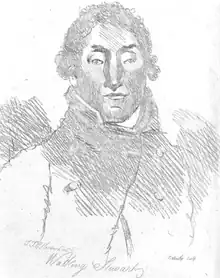Walking Stewart | |
|---|---|
 | |
| Born | John Stewart 19 February 1747 |
| Died | 20 February 1822 (age 75) London, England |
John "Walking" Stewart (19 February 1747 – 20 February 1822) was an English philosopher and traveller. Stewart developed a unique system of materialistic pantheism.[1]
Travels
Known as "Walking" Stewart to his contemporaries for having travelled on foot from Madras, India (where he had worked as a clerk for the East India Company) back to Europe between 1765 and the mid-1790s, Stewart is thought to have walked alone across Persia, Abyssinia, Arabia, and Africa before wandering into every European country as far east as Russia.
Over the next three decades Stewart wrote prolifically, publishing nearly thirty philosophical works, including The Opus Maximum (London, 1803) and the long verse-poem The Revelation of Nature (New York, 1795). In 1796, George Washington's portrait-painter, James Sharples, executed a pastel likeness of Stewart for a series of portraits which included such sitters as William Godwin, Joseph Priestley, and Humphry Davy, suggesting the intellectual esteem in which Stewart was once held.
After his travels in East India, Stewart became a vegetarian.[2] He was also a teetotaler.[3]
Materialistic pantheism
During his journeys, he developed a unique system of materialist philosophy which combines elements of Spinozistic pantheism with yogic notions of a single indissoluble consciousness. Stewart began to promote his ideas publicly in 1790 with the publication in two volumes of his works Travels over the most interesting parts of the Globe and The Apocalypse of Nature (London, 1790).
Historian David Fairer has written that "Stewart expounds what might be described as a panbiomorphic universe (it deserves an entirely new term just for itself), in which human identity is no different in category from a wave, flame, or wind, having an entirely modal existence."[1]
Retirement
After retiring from travelling, Stewart eventually settled in London where he held philosophical soirées and earned a reputation as one of the city's celebrated eccentrics.[4] He was often seen in public wearing a threadbare Armenian military uniform. John Timbs described Stewart as one of London's famous eccentrics.[4]
Death
On 20 February 1822, the morning after his seventy-fifth birthday, 'Walking' Stewart's body was found in a rented room in Northumberland Place, near present-day Trafalgar Square, London. An empty bottle of laudanum lay beside him.
Literary influence
After Walking Stewart's travels came to an end around the turn of the nineteenth century, he became close friends with the English essayist and fellow-Londoner Thomas De Quincey, with the radical pamphleteer Thomas Paine, and with the Platonist Thomas Taylor (1758-1835).
In 1792, while residing in Paris in the weeks following the September Massacres, he made the acquaintance of the young Romantic poet William Wordsworth, who later concurred with De Quincey in describing Stewart as the most eloquent man on the subject of Nature that either had ever met. Recent scholarship by Kelly Grovier has suggested that Stewart's persona and philosophical writings had a major influence on Wordsworth's poetry.
References
- 1 2 Fairer, David. (2009). Organising Poetry: The Coleridge Circle, 1790-1798. Oxford University Press. p. 53. ISBN 978-0-19-929616-3
- ↑ Preece, Rod. (2008). Sins of the Flesh: A History of Ethical Vegetarian Thought. UBC Press. p. 243. ISBN 978-0-7748-15093
- ↑ Taylor, Harvey. (1997). A Claim on the Countryside: A History of the British Outdoor Movement. Keele University Press. p. 56. ISBN 978-1853311666
- 1 2 Timbs, John. (1875). English Eccentrics and Eccentricities. London: Chatto and Windus. pp. 300-304
Further reading
- The life and adventures of the celebrated Walking Stewart: including his travels in the East Indies, Turkey, Germany, & America. By a relative, London, E. Wheatley, 1822.
- Bertrand Harris Bronson, "Walking Stewart", Essays & Studies, xiv (University of California Press, 1943), pp. 123–55.
- Chisholm, Hugh, ed. (1911). . Encyclopædia Britannica. Vol. 25 (11th ed.). Cambridge University Press. p. 914.
- Gregory Claeys. "'The Only Man of Nature That Ever Appeared in the World'": 'Walking' John Stewart and the Trajectories of Social Radicalism, 1790-1822", Journal of British Studies, 53 (2014), 1–24.
- Thomas De Quincey, The Works of Thomas De Quincey, ed. Grevel Lindop (London: Pickering & Chatto, 2000-), vol. xi, p. 247.
- Kelly Grovier, 'Dream Walker: A Wordsworth Mystery Solved', Times Literary Supplement, 16 February 2007
- Kelly Grovier, '"Shades of the Prison House": "Walking" Stewart and the making of Wordsworth's "two consciousnesses", Studies in Romanticism, Fall 2005 (Boston University), pp. 341–66.
- Barry Symonds, 'Stewart, John (1747–1822)’, Oxford Dictionary of National Biography, Oxford University Press, 2004
- John Taylor, "Walking Stewart", Record of My Life, pp. 163–68